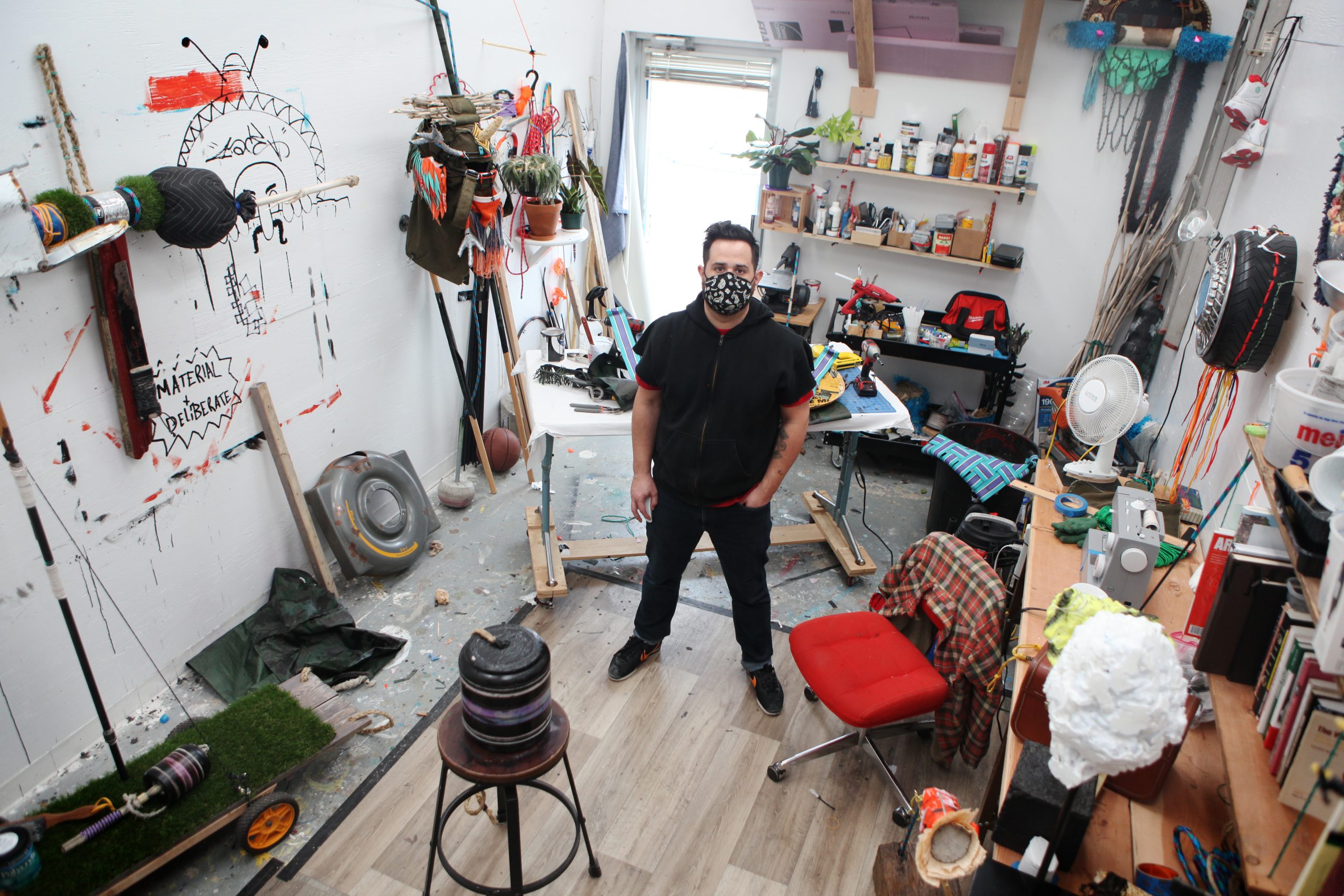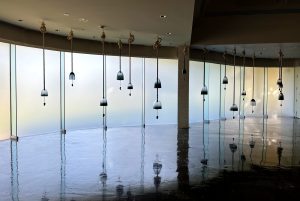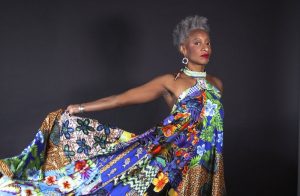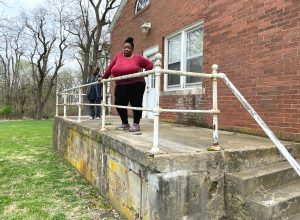During the summer of 2020, with COVID-19 cases rapidly rising, it became clear that higher education would have to look different in the near future.
There was a lot of press coverage about how colleges and universities could, would, and should function during a global pandemic. How could it be safe to bring tens of thousands of people to one place, many of them living three or four to a space? How could students continue their education under these stressful conditions? What type of accommodations should be made to allow for those who want to return to campus to do so safely? What about fiscal solvency? A lot of conversations and articles about the reopening of college campuses were about economics, the ways a virtual or hybrid model could greatly alter or damage traditional ideals of higher education, and the exploitation of professorial labor (both tenured and nontenured).
The University of Illinois system originally announced in mid-June that Fall 2020 would be a hybrid model of education, with in-person and online classes. This model was continued into the current Spring 2021 semester. It is likely that despite increases in vaccinations, Fall 2021 will also be hybrid, though with the possibility of more in-person instruction with new physical distancing and safety protocols. The onus of adapting and developing analog courses for online platforms fell to professors and instructors, many of whom were not as fluent in these newer technologies. Already put in the position of being content expert, teacher, and part-time mental health professional, professors and instructors suddenly found themselves having to also become information technology specialists.
Lectures and seminars seemed a little easier to adapt, but what about studio art courses? I was particularly curious about this aspect, where so much of what is learned is through the communal experience of working in the same space, for the same amount of time, often on the same project. Generally studio art courses are fewer than 20 students, in one room, each at an easel or workstation. Professors and instructors give demos, and have the ability to intervene directly with a student as they work. That sort of thing just isn’t possible through an online learning platform.
At the University of Illinois at Urbana-Champaign’s School of Art + Design, much of the final two years at the undergraduate level is about learning to build work habits for post-graduation and a cohesive body of work. For seniors, this culminates in the BFA exhibition at Krannert Art Museum (KAM). At UIUC, junior and senior undergraduate Studio Arts majors are given studio spaces. These spaces are cubicle-style in large rooms, so they have some privacy, but ultimately they are working in a shared space. Students are almost never working in solitude.
Graduate students in the UIUC Studio Arts MFA program faced the dual challenge of having to be students and instructors. In their third years, they are teaching and preparing their work for the MFA exhibition at KAM. It’s a massive undertaking in normal times. Under COVID, it seems nearly insurmountable.
I spoke with four students (three undergraduate, one graduate) about how they were adjusting to learning — in one case, learning and teaching — in these conditions. I was impressed by their resilience and flexibility.
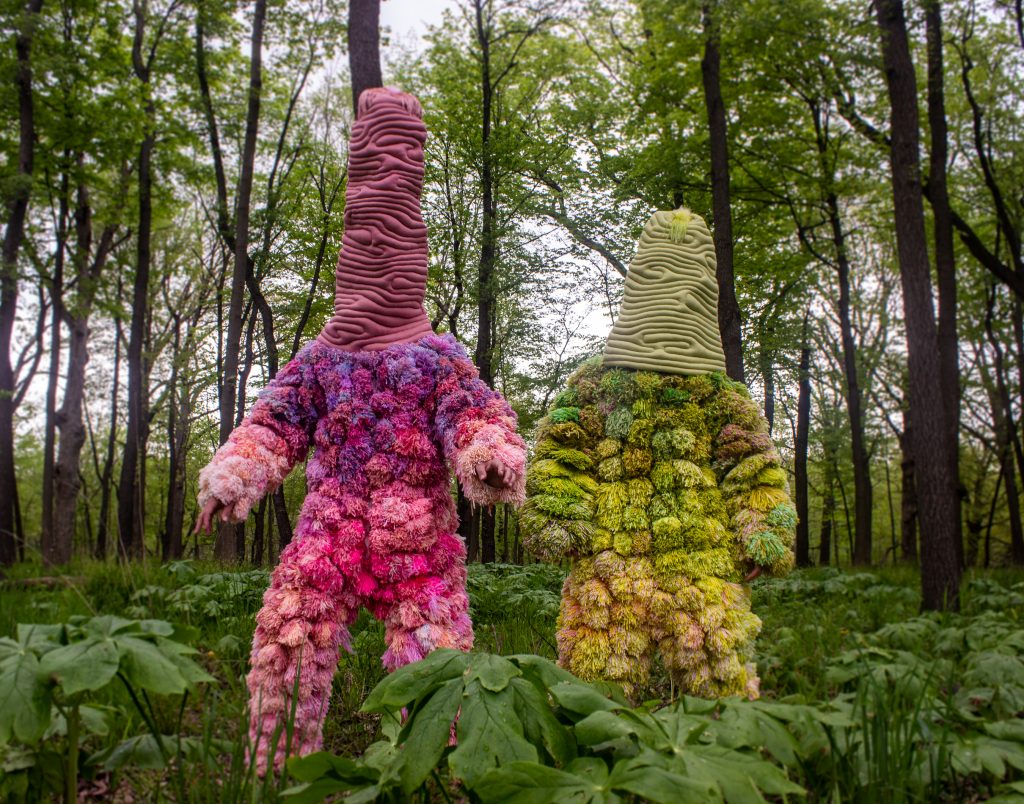
Brendan O’Shaughnessy, a senior Painting and Fish and Wildlife Conservation major, returned to campus and his on-campus studio. A highly motivated student, he notes that he was able to “continue making artwork during this pandemic without many challenges.” He said that the UIUC’s COVID safety protocols, which include testing several times a week, were the reason he decided to return to campus in the fall. O’Shaughnessy was really excited to be able to live and work on campus, and maintain his UIUC-provided studio. Though most students were not also working there, he was able to bond with those who were. They cheered each other on.
O’Shaughnessy’s studio art classes were delivered online. “Both classes have been fairly successful in their ability to deliver information and promote discussions,” he said. “However, they have been unsuccessful in regards to critiques. This is solely due to their format, and not the instructors. It is difficult to visually understand and critique artwork via screens.” The irony of this was not lost on him: “This is funny, because most of the art that people engage with is through social media and the internet.”
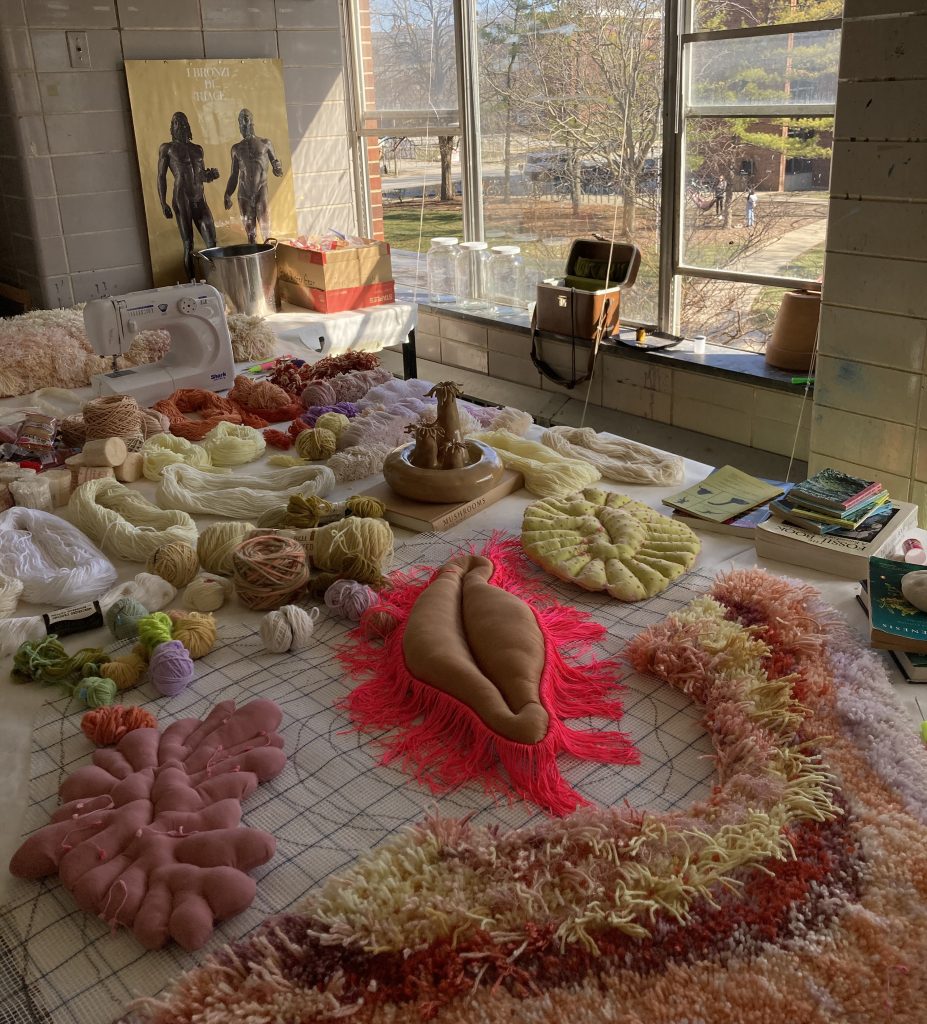
There is something ironic about that. I’m struck by the gap between what seems to be common in studio courses versus art history courses, and the ways in which the art students, at least by O’Shaughnessy’s account, aren’t explicitly able to traverse that terrain. It is clear to me that the expectations are different. In a studio course, there are a lot of opportunities to critique the technical and formal elements of a work, especially as an undergraduate. Undergrads simply don’t have the same experience making as, say, a Jan Van Eyck or Artemisia Gentileschi. Art History prioritizes the history — that is, the intent and implied meanings, the reception of the work in the world. There is so much to learn about material and how to be a maker at the undergraduate level, that even if and when the concepts are there, the work, of course, hasn’t had time to live in the world among people.
Linda Obobaifo, a junior painting major who elected to stay at home, echoed O’Shaughnessy’s sentiments about learning through Zoom. “Shifting from having in-person classes to all online has been a challenge. The main problem faced is having a lack of in-person communication with classmates and professors. Zoom classes have been very isolating. There is usually a poor connection on either the student or professors’ side, resulting in words being cut-out [or] broken up, making the communication harder for everyone.”
She noted the challenges of having to share space and bandwidth with other members of the house: “I also personally have other family members who work from home and have online classes, which creates this challenge of having to maintain focus and stay motivated.”
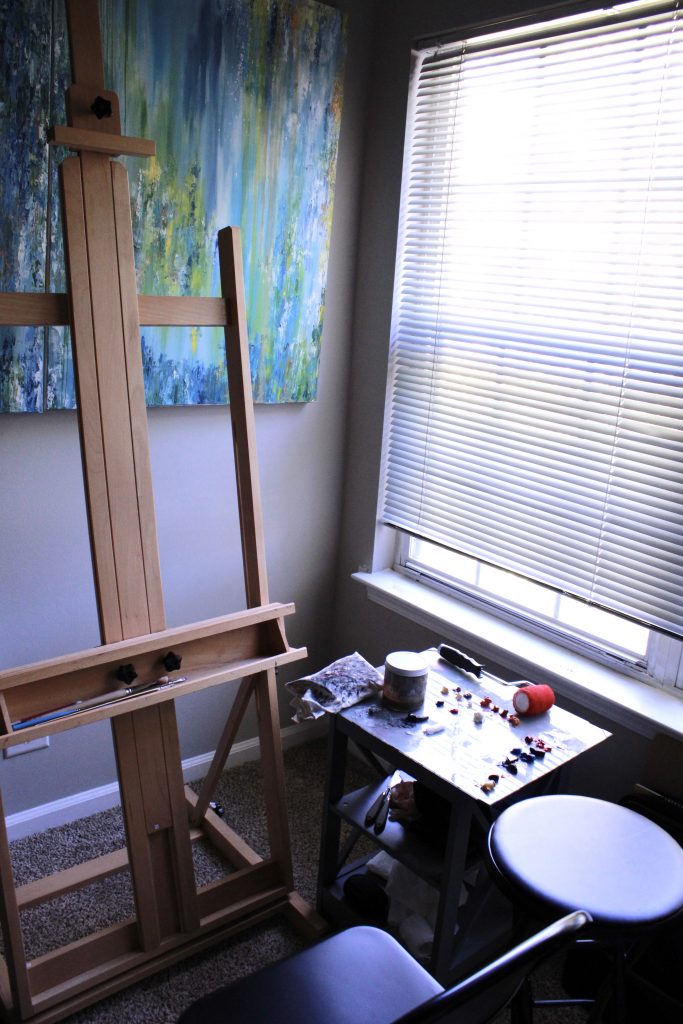
Being creative and making creative work is personal, difficult, and consuming. It requires focus and dedication, and sharing aural, visual, and physical spaces with others can zap that energy and focus. Even though I’m very far removed from an educational setting, I imagine the stress of having to produce something for review under these challenging circumstances is somewhat terrible.
For Obobaifo, flexibility from her professors has been key. “The most successful aspects of the studio are being able to continue to have discussions through zoom while having the remainder of the week to work on my projects,” she said. “It creates a more flexible schedule to work on my own time.”
Unlike O’Shaughnessy, because Obobaifo isn’t on campus and doesn’t have access to all the amenities provided by the School of Art + Design, she is limited in the types of work she can produce. But like O’Shaughnessy, Obobaifo also misses analog interactions with her peers “sharing in-progress works while also providing feedback to one another outside of the classroom settings.”
Pascale Grant is a senior double major in Painting and Graphic Design. She elected to stay home, and has been working in her basement. While she’s enjoyed being able to work at her own pace, she, too, is missing the camaraderie found in her peers. She noted that her father and sister were working from home in the same basement space, and she enjoyed their company.
Critique is essential to the art-making process and learning, especially in a field where audience feedback is ultimately shielded. Unlike dance or theater or music, for instance, “fine art” makers aren’t necessarily producing for a captive audience. Critique in an educational setting provides a unique opportunity to receive immediate feedback on both completed and in-progress work. It’s critical to technical and conceptual development, and it’s the sort of community that is not readily available post-graduation. The preciousness of four years of this type of in-person education is not lost on these students.
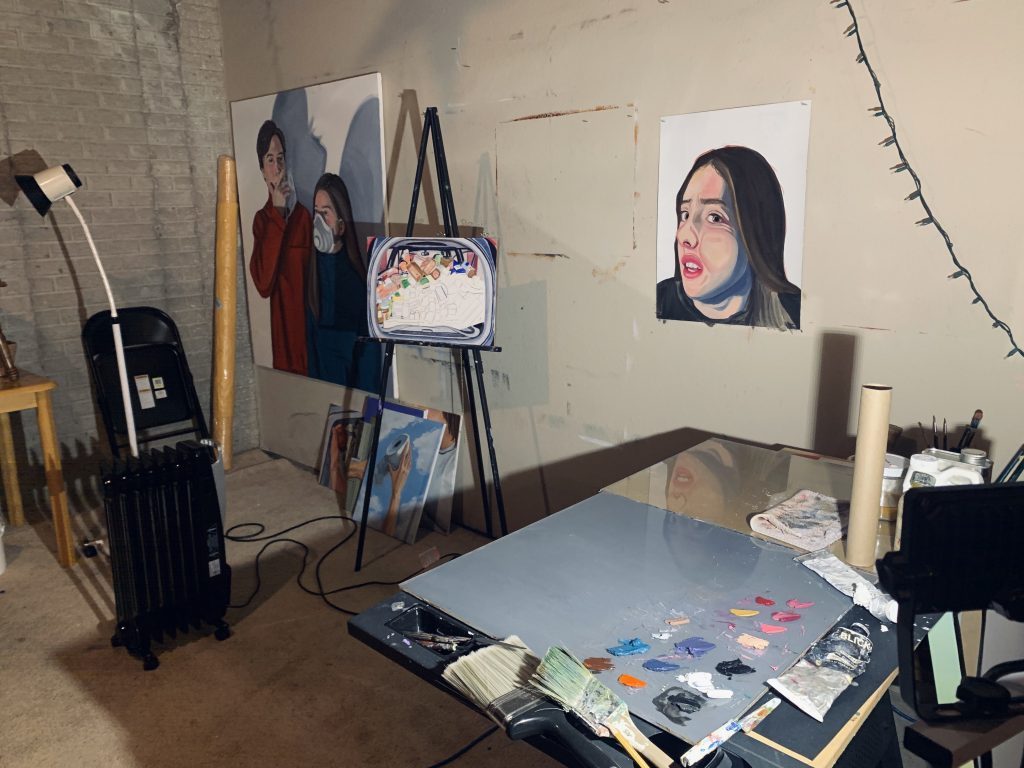
The ability to access School of Art + Design resources appears to be key for many students. Without access to high quality photo equipment, a processing lab, and a variety of high-end printers, Grant notes that she now has a “more realistic expectation of what making work will be like after graduation,” when she won’t necessarily have the latest tech or ideal working conditions. She followed up, “I believe that I can make work regardless of having all the tools accessible or not. I think that as creative people, we can get creative with our materials. I’m not as worried anymore about the future of my own art practice with that in mind.”
Considering the frustrations of online learning and critiquing, Grant and her peers have been keeping in touch with each other through group chats on social media and Zoom. There have been the rare in-person COVID-safe meetings, and it’s clear from my conversation with her that there is a group of students who are trying to build and maintain a community despite their isolation.
As undergraduates, O’Shaughnessy, Obobaifo, and Grant are responsible for soaking in as much information as possible while they figure out how and what they want to do as makers. In the before times, the juniors and seniors worked alongside their peers in adjoined studio spaces. This proximity and opportunity for casual conversation is unique to this particular space. It’s nearly impossible to replicate in the “real world” on a regular basis.
It is possible to replicate in graduate school, though the expectations are a little different. Stephen Signa-Aviles is a third year MFA candidate in Studio Arts whose work is primarily sculptural. In the fall semester, he taught two classes (Painting for Non-Majors and Introduction to Sculpture) via Zoom. In the spring of their third years, MFA students mount their thesis work. The fall semester is a vital time for finalizing pieces and putting together the textual materials necessary for the exhibition and graduation.
As you might imagine, moving analog classes online is a huge undertaking. All of those conversations and lectures that happen in two-hour-and-forty-minute studio courses needed to somehow be captured in a way that was accessible to students. Notes became prose, prose became video. All of that content then has to be uploaded and organized, and we have all had those moments where downloading and uploading to the internet has been a hot mess, if you will.
Signa-Aviles confirmed this with me in our email exchange: “Teaching is difficult, very time consuming. I feel awful about how my students are having to learn sculpture [without] the actual presence of someone who has a lot to offer in terms of interaction with [and] mastery of the given material we’re focusing on.” Signa-Aviles clearly feels stifled in his ability to offer his expertise because of the class format, though based on the student projects he shares on Instagram, the students are clearly still learning and making interesting work.
As a student, though, Signa-Aviles expressed similar frustrations as the undergraduates I spoke with, noting that his seminar through Zoom “feels stale and reduced to the sum of its parts. It’s made me really appreciate the physical presence of other human beings in conversation/dialogue.” He continues, “if we’re not sharing space together how can we regard/care for the well-being (material, emotional, spiritual) of others? It makes disagreement and robust dialogue all the more difficult.” This is further compounded by the lack of diversity in the UIUC Studio Arts graduate program, where he is the only person of color. “Combine this with the educational/social isolation of COVID then you’re left with something pretty dismal,” he concludes.
Signa-Aviles is the only student I spoke with to address this explicitly, in part, I imagine, because he is older and more experienced, and the topics and theories discussed at the graduate level are different than those discussed at the undergraduate level. That sort of emotional and intellectual labor is already cumbersome and intense, and coupled with the uncertainty of our current times, Signa-Aviles explains how heavy the burden is:
I absolutely feel the increased occupation of (mental) space. It’s more difficult to relate to my students. Through physical isolation, their making suffers (both craft and conceptually). I can’t be with them, and so I try to compensate with emails, videos, and zoom sessions. Which demands a lot more time than just being with them all in one classroom. Not to mention I’m constantly asking myself ‘what are they seeing/thinking’ or ‘what questions might this cause them to ask about completing the work?’
Then I start to think about how I’m a Graduate Student. I’m here to investigate and produce research and artwork. But I’m essentially treading into a format that no one (faculty included) has much if any experience in. In addition to being an instructor of record (writing syllabus, defining core competencies), I’m also improvising and retrofitting an entire subject for online learning. So I’m expected to be on-par with tenured faculty [without] the experience of solidifying my own research goals and meeting the challenges of COVID — teaching actually inhibits me from devoting the time and care to my studies that I came here for.
The pandemic has required graduate students to build new and adapt old courses to an online platform, labor that is happening simultaneously with finalizing graduate work to complete a terminal degree. It sounds massively burdensome. As Signa-Aviles suggests, it is not only time consuming, it occupies a lot of mental space, limiting the possibilities for creative development and discovery. As a graduate student, his labor and interests are not nearly as protected as tenured faculty. It’s hard to imagine that all of the promises made to him as a graduate student — to earn money and experience through teaching, but also have time, space, and support to develop as an artist — were fulfilled in earnest.
A unifying thread among these students is that of missing the in-person camaraderie and attention that is afforded simply by occupying the same physical space. While it seems like these students had flexible, empathetic professors, there was no road map or rubric for creating in crisis. The pressure on students who need to perform and meet expectations during a global pandemic that has killed more than half a million people (and tested physical and emotional well-being and financial security) is not always explicitly centered. What will be the lasting effects on these students, if any? Will this pandemic experience influence the ways they approach art making in the future? There may not be an easy way to know or measure that right now.
I’m impressed by the maturity of these students and their thoughtfulness in considering their own well-being and futures. I keep returning to something O’Shaughnessy said: “This experience has taught me that it’s ok to take breaks. Giving yourself time for self-care is an important part [of] sustaining your artistic practice. It has helped me maintain ‘normal’ levels [of] productivity and creativity during an incredibly stressful time.” Obobaifo echoed the same sentiment: “There is a time [and] a place to create a certain type of larger-scale work, and then there are perfect opportunities to create smaller-scaled works. As long as I am creating something, I classify that as a win. Initially, I would dedicate 8 to 12 hours a day to my art. I now allow myself to breathe more, taking more time out of my day to better my overall health and well-being. Because of this, it brings more clarity to my creative process. I am not as overwhelmed as before.” In the end, if we don’t take care of ourselves, who will?
Featured Image: Stephen Signa-Aviles stands in his studio at the University of Illinois at Urbana-Champaign. He is wearing dark jeans and a dark, short-sleeved hooded sweatshirt, and a black face mask with a white graphic pattern. He looks up and into the camera. His studio space is narrow and cluttered. There are various works in progress, as well as shelving units with paints, books, and other materials. Photo courtesy of Stephen Signa-Aviles.
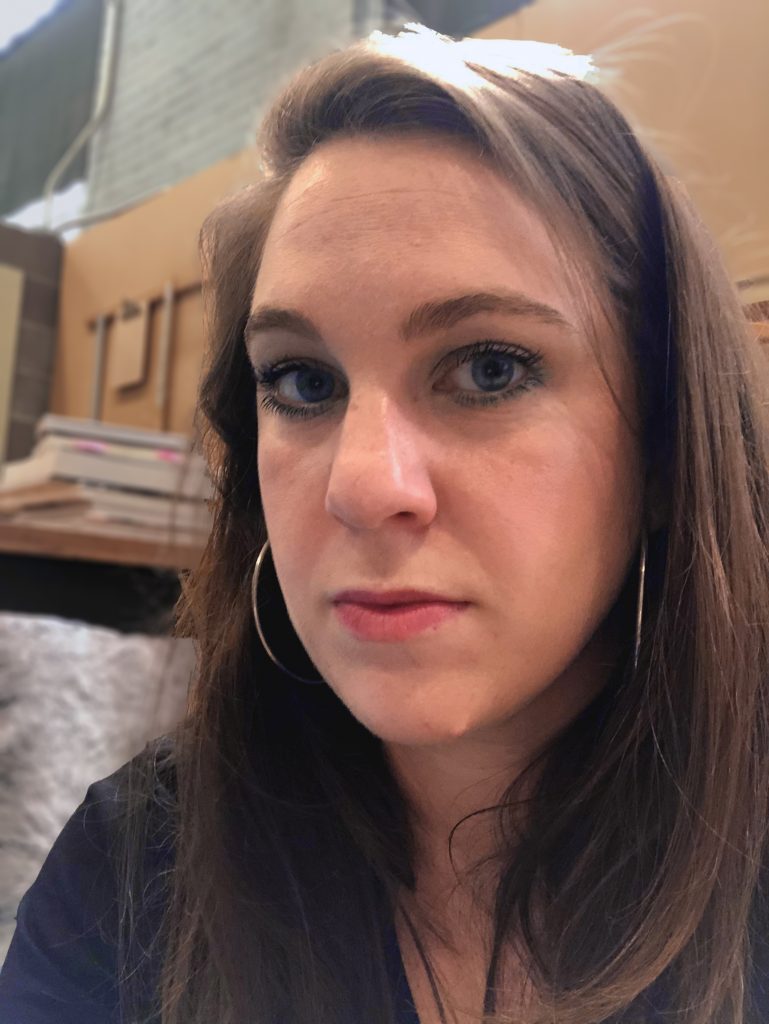
Jessica Hammie is a writer based in Champaign, Illinois. She is interested in the ways in which artists visualize identity, and how we come to understand our histories. In addition to writing for Sixty, Jessica is a Managing Editor at Smile Politely, a Champaign-based culture magazine.
